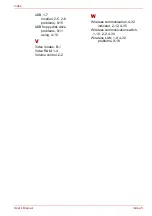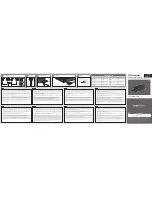
User’s Manual
Glossary-12
parity:
1) The symmetrical relationship between two parameter values
(integers) both of which are either on or off; odd or even; 0 or 1.
2) In serial communications, an error detection bit that is added to a
group of data bits making the sum of the bits even or odd. Parity can
be set to none, odd, or even.
password:
A unique string of characters used to identify a specific user.
The computer provides various levels of password protection such
as user, supervisor and eject.
pel:
The smallest area of the display that can be addressed by software.
Equal in size to a pixel or group of pixels.
See
pixel.
peripheral component interconnect:
An industry standard 32-bit bus.
peripheral device:
An I/O device that is external to the central processor
and/or main memory such as a printer or a mouse.
pixel:
A picture element. The smallest dot that can be made on a display or
printer. Also called a pel.
plug and play:
A capability with Windows that enables the system to
automatically recognize connections of external devices and make
the necessary configurations in the computer.
port:
The electrical connection through which the computer sends and
receives data to and from devices or other computers.
Power Saver Utility:
A TOSHIBA utility that lets you set the parameters for
various power-saving functions.
printed circuit board (PCB):
A hardware component of a processor to
which integrated circuits and other components are attached. The
board itself is typically flat and rectangular, and constructed of
fiberglass, to form the attachment surface.
program:
A set of instructions a computer can execute that enables it to
achieve a desired result.
See also
application.
prompt:
A message the computer provides indicating it is ready for or
requires information or an action from you.
R
Radio frequency interference (RFI) shield:
A metal shield enclosing the
printed circuit boards of the printer or computer to prevent radio and
TV interference. All computer equipment generates radio frequency
signals. The FCC regulates the amount of signals a computing
device can allow past its shielding. A Class A device is sufficient for
office use. Class B provides a more stringent classification for home
equipment use. TOSHIBA portable computers comply with Class B
computing device regulations.
Random Access Memory (RAM):
High speed memory within the
computer circuitry that can be read or written to.
Содержание Tecra S4
Страница 1: ...User s Manual TECRA S4 ...
Страница 2: ...ii User s Manual ...
Страница 10: ...User s Manual x ...
Страница 102: ...4 42 User s Manual Operating Basics ...
Страница 112: ...5 10 User s Manual The Keyboard ...
Страница 140: ...7 12 User s Manual HW Setup BIOS Setup ...
Страница 162: ...8 22 User s Manual Optional Devices ...
Страница 184: ...9 22 User s Manual Troubleshooting ...
Страница 188: ...10 4 User s Manual Legal Footnotes ...
Страница 192: ...A 4 User s Manual Specifications ...
Страница 204: ...D 6 User s Manual TOSHIBA RAID ...
Страница 212: ...E 8 User s Manual Bluetooth wireless technology Interoperability ...
Страница 216: ...G 2 User s Manual TOSHIBA Anti theft Protection Timer ...
Страница 238: ...Index 6 User s Manual Index ...









































